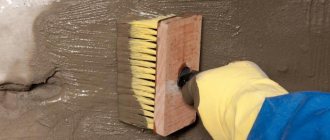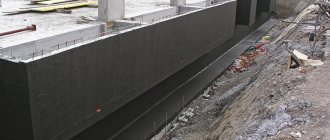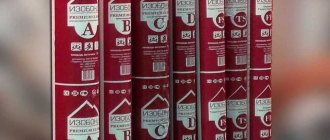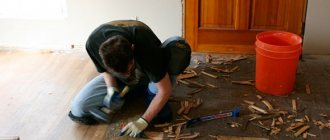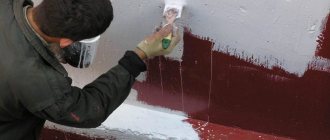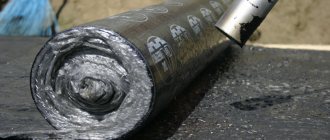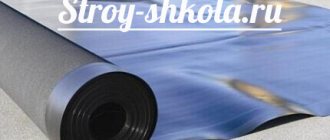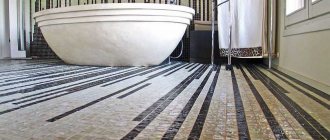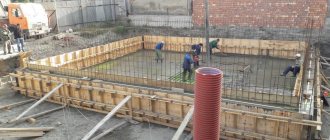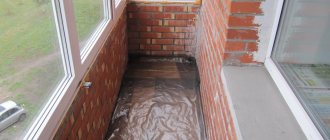What is Penetron
The dry mixture called “Penetron” was developed, patented and produced by the company of the same name. The name comes from the Latin word penetro, which means “to penetrate.” It includes:
- cement;
- fine quartz sand;
- special chemical additives.
The mixture belongs to the category of penetrating waterproofing. It protects concrete and reinforced concrete structures from moisture and aggressive environments, and increases their strength. With its use, corrosion of reinforcement is significantly reduced, the material becomes less susceptible to frost, therefore, it is less destroyed, and its service life increases.
The main component of the mixture are active additives that form moisture-proof structures inside the concrete. Thanks to them, Pentron can penetrate to a distance of about 0.5 m from the surface. This is the best indicator among other similar materials.
Application
Penetron, diluted in water, is used for waterproofing a wide variety of structures made of concrete or reinforced concrete of grade M100 and higher, as well as concrete surfaces on which cement-sand plaster of grade not lower than M150 has been applied. Example usage are:
- foundations;
- liquid storage tanks;
- basements and cellars;
- wells and mines;
- tunnels.
The size of cracks on the surface of the structure should not exceed 0.4 mm. If there are seams, joints or large cracks, then it is necessary to use Penecrit together with Penetron.
The waterproofing substance will not penetrate into brickwork, stone, foam concrete, etc. If you use it on the listed materials, the positive effect will not occur, and the degree of moisture penetration will not change. It is necessary to plaster the surface with a solution of cement and sand to obtain a high-density concrete layer, and only then begin to apply Penetron.
Did you ask? We answer.
Can Penetron be applied to a damp surface?
One of the advantages of the system materials is that there is no need to dry the concrete surface. And if the surface is dry, then it must first be thoroughly moistened. The main thing is that there is no standing water on the surface being treated.
What is the consumption of Penetron system materials?
The consumption of Penetron material is 0.8 kg/m² when applied in two layers. An increase in consumption (up to 1.1 kg/m²) may occur if there are cavities or potholes on the surface. The consumption of Penecrit material in terms of dry mixture with a 25x25 mm groove is 1.5 kg/l.m. It should be taken into account that as the cross-section of the groove increases, the consumption of the Penecrit material changes proportionally. The consumption of Peneplag and Waterplug materials in terms of dry mixture is 1.9 kg per liter of leak cavity. The dosage of Penetron Admix is 1% of the dry mixture by weight of cement in the concrete mixture. If the amount of cement in concrete is unknown, then the calculated consumption of Penetron Admix material per 1 m³ of concrete is 4 kg.
How to prepare a solution of Penetron and Penecrit?
Penetron: mix the dry mixture with water in the following proportion: 400 grams of water per 1 kg of Penetron material. Pour water into the dry mixture (not vice versa). Mix for 1-2 minutes by hand or using a low-speed drill. The type of prepared mixture is a liquid, creamy solution. Prepare a quantity of solution that can be used within 30 minutes. During use, stir the solution regularly to maintain the original consistency. Repeated addition into the solution is not allowed. Penecrit: mix the dry mixture with water in the following proportion: 200 grams of water per 1 kg of Penecrit material. Mix for 1-2 minutes. The type of prepared mixture is a thick plasticine-like solution. Prepare a quantity of solution that can be used within 30 minutes. Stir the solution regularly during use. Re-adding water to the solution is not allowed.
The brick wall is plastered with lime mortar. It is necessary to waterproof the wall. How to do it?
First of all, the existing lime plaster must be removed. When waterproofing brick or stone structures, the surface must be plastered and treated with a solution of Penetron material. In this case, the following conditions must be observed; — plastering should only be done with a cement-sand mortar of a grade not lower than M150. The use of lime and gypsum plaster is prohibited. — plastering should only be done using a masonry mesh (mesh size 50×50 mm or 100×100 mm), firmly fixed to the surface; - the gap between the masonry mesh and the brick base must be at least 15 mm; — thickness of the plaster layer – at least 40 mm; — the structure of the plaster layer should be dense, without air gaps; — it is recommended to carry out plastering continuously to avoid the formation of working seams. Along the working seams and junctions, you need to make a 25x25 mm groove and seal it with Penecrit solution. Leave plastered surfaces for at least 24 hours before treating with Penetron material. The consumption of Penetron in terms of dry mixture, taking into account the application of two layers, is 0.8 kg/m².
How to prepare a solution of Waterplug and Peneplag?
Mix a handful of dry mixture with water in the following proportion: 150 grams of water per 1 kg of “Peneplug” (“Waterplug”) material. If the leak is severe, reduce the amount of water added to the mixture. The type of prepared solution is “dry earth”. Prepare such an amount of solution that can be used within 1 minute (for the Peneplag material) and 2 minutes (for the Waterplug material), since the solutions set very quickly.
What materials and how are used for waterproofing bathrooms (toilets)?
At the junctions between wall and floor, between walls and ceiling, at the seams between the slabs, make a U-shaped groove measuring 25x25 mm. Clean the concrete surface and use a wire brush to remove dust, dirt, and lime plaster. Moisten the concrete surface to be treated. Prepare a Penecrit solution and fill the groove with it as tightly as possible. Apply the Penetron solution in two layers to the concrete surface and to the grooves. In this case, the interval between applications should not exceed six hours. Before applying the second layer, moisten the surface. To waterproof the ceiling (or floor) and junctions in a bathroom with dimensions of 3x2 m, about 5 kg of Penetron and 15 kg of Penecrete are required.
Is it always necessary to apply a second layer of Penetron when processing a concrete monolith, or can the consumption be reduced and one layer applied?
Yes, always. To achieve an effective result, i.e. To fully waterproof a concrete mass, it is necessary to apply Penetron in two layers. This will make it possible to evenly distribute the concentration of the chemically active part of Penetron on the surface, as a result of which the uniform formation and growth of crystals in the concrete mass is guaranteed, and, accordingly, ensuring the waterproofness of the treated part of the structure.
How does Penetron Admix work with other additives (plasticizers, antifreeze, sealants, etc.)?
This material is fully compatible with all additives used in the preparation of concrete mixtures.
How to calculate the Penecrit consumption if my groove size is 25x35 mm?
In this case, the consumption of Penecrit increases in proportion to the increase in the size of the groove. It is calculated as follows: with a groove of 25×25 mm (cross-sectional area of the groove is 625 mm²), the material consumption is 1.5 kg/m.p. with a groove of 25×35 mm (cross-sectional area of the groove is 875 mm²) material consumption – X kg/m.p. We make up the proportion: 625 = 1.5 875 = X Therefore, with a groove of 25 × 35 mm, the consumption of Penecrete will be X = 875 * 1.5-625 = 2.1 kg/m.p.
What material should be used to fill the hole in a monolithic wall left from attaching the formwork?
For waterproofing in this case, the materials Penetron and Penecrit are used. It is necessary to remove the plastic sleeve using a drill and clean the hole from dust. Fill the hole with mounting foam or a piece of polyethylene foam so that cavities 20-25 mm deep remain along the edges of the hole on the outside or inside. Moisten the cavities, fill them with a solution of Penecrit material, pressing and compacting it firmly. Moisten the areas filled with the Penecrit solution and the adjacent areas within a radius of 20 cm, and apply a solution of the Penetron material to them with a brush.
How much Penetron Admix mixture will be needed to prepare 15 m³ of concrete?
"Penetron Admix" is added to concrete in an amount of 1% by weight of cement. If the mass of cement in the concrete mixture is not known, we recommend using 4 kg per 1 m³. That is, you will need 60 kg of material.
How to prepare Penetron Admix solution and how to introduce it into concrete?
Mix the calculated amount of the additive with water to form a very weak solution (750 ml of water per 1 kg of dry mixture). Pour water into the dry mixture (not vice versa). Mix for 1-2 minutes using a low-speed drill. Prepare the amount of solution of the Penetron Admix material that can be used within 5 minutes. When used on a construction site, you need to pour the prepared Penetron Admix solution into a concrete mixer, and then continue mixing the concrete mixture for at least 120 minutes. Next, the concrete mixture is poured in accordance with the rules for carrying out concrete work.
Is it possible to treat the foundation at a temperature in the basement of about +5...+8, and outside -15...-20
The use of Penetron system materials is allowed at an average daily temperature of air and concrete surface not lower than +5! This temperature must be maintained for 28 days after completion of work using Penetron system materials. If the treatment is carried out from the inside, where the air and surface temperature during the specified period does not fall below +5, then the treatment can be carried out.
How to prepare a solution of Skrepa M500 material?
Mix the dry mixture with water in the following proportion: 165 ml of water per 1 kg of dry mixture. It is recommended to mix no more than 15 kg of material at a time. Pour water into a clean mixing container. Mechanical mixing with a low-speed drill (500-650 rpm) is optimal. If mixing by hand, mix vigorously to achieve a uniform consistency of the material. Add ¾ of the calculated amount of dry mixture, mix until a homogeneous solution is obtained. Then add the rest of the dry mixture and continue mixing. Initially the material has a high viscosity, which decreases as it is mixed. Mix for 5 minutes until a plastic homogeneous mass is formed. The mixture should look like putty.
Is it possible to glue ceramic tiles to concrete treated with Penetron?
You can glue the tiles, but it is advisable to wait 28 days from the moment of processing before applying the decorative coating. To improve adhesion, it is necessary to mechanically clean the treated surface.
Is it possible to use Penetron as a roofing material on a flat concrete roof of a five-story residential building (remove roofing material, treat with Penetron)?
Yes, the use of Penetron materials for flat roofs is possible. The main thing is to take into account when installing waterproofing that the grade of concrete must be at least M100 (in the case of a cement screed - at least M150), and that seams and cracks must be insulated with Penecrit material.
Is sandblasting a concrete surface used before applying Penetron?
We do not recommend sandblasting the surface, since in this case it is not effective (the pores of the concrete become clogged with dust). To clean the surface, a high-pressure water jet or mechanically (a brush with metal bristles) is used, followed by thorough wetting.
After what period of time can a pit be backfilled after repairing cracks and waterproofing the outer wall?
It is recommended to carry out backfilling no earlier than 3 days after treatment with Penetron system materials.
How to care for a surface treated with Penetron?
For 3 days after treatment, it is necessary to protect the surface from mechanical influences and the influence of negative temperatures. You also need to ensure that the surface remains damp during this time (use water spray or cover the concrete with a damp, rough cloth or plastic film).
What is the method for applying Penetron solution to a large surface area?
Is spray application allowed? Yes, of course, you can use a mortar pump with a spray nozzle.
Is it possible to use Penetron on a wall affected by fungus?
The presence of fungus is not a reason why Penetron should not be used. Before applying the Penetron solution, the surface must be cleaned with a brush with metal bristles and moistened.
What primer should be used before applying Penetron to the surface of the floor slab?
If the surface does not have significant damage (in this case, the repair composition Skrepa M500 is used), then there is no need to use a primer when applying Penetron. The Penetron material solution is applied directly to a cleaned and moistened concrete surface.
I treated the basement walls with Penetron, because... There is no external waterproofing (the basement walls are monolithic). A year later, this coating began to peel off in some places. Is this a normal phenomenon or not, and will the plaster come off in these places?
We do not have a finishing material, but a penetrating waterproofing material, i.e. it is important to ensure the penetration of chemical components into the concrete structure and at the same time, what remains on the surface (cement - sand matrix) does not play any role! Before applying finishing coatings, it is necessary to clean (28 days after applying Penetron materials) the concrete surface from any flaking, using brushes with metal bristles or another acceptable method.
How to stop a leak along the seam between reinforced concrete rings (at the seams between FBS blocks)?
If there are leaks between the rings, initially prepare a cavity with an expansion inward (give it a “dovetail” shape) with a depth of at least 540 mm. Next, you should prepare the required amount of solution of the Waterplug material. Fill the dovetail-shaped leak cavity halfway with a solution of Waterplug material, press and hold for 2-3 minutes. Prepare a solution of the Penetron material. Treat the internal leak cavity with it. Fill the remaining cavity with a solution of Penecrit material. And treat the top with 2 layers of Penetron solution.
Why did the walls treated with Penetron turn white over time in some places, while in others they remained dark gray?
The variety of colors of the cement-sand matrix of the Penetron material is associated with the composition of the concrete mixture or different compaction when pouring concrete.
Salt build-ups have formed on the surface treated with Penetron, is this normal or not?
Salt build-up can be caused by Penetron penetrating material and can be removed with an efflorescence cleaner if desired.
We use Penetron Admix. Is it necessary to take any additional measures in the case when, at the concreting stage, 1-2 days pass between pouring concrete to reinstall the formwork?
Yes, if the difference in the timing of concreting adjacent sections of a reinforced concrete structure is more than 6 hours, a “cold” joint is formed, which must be sealed with Penebar material (for new construction before subsequent pouring) or Penecrit material (for an existing cold joint), since concrete shrinks upon setting, a crack with an opening of more than 0.4 mm is formed in this place. Self-healing of cracks when using the concrete additive Penetron Admix is effective for cracks with an opening less than or equal to 0.4 mm. If cracks larger than 0.4 mm appear in a concrete structure, they must be sealed with Penecrete.
Please advise what products to use for waterproofing the basement (if only internal insulation is possible). The base is a monolithic concrete slab, the walls are made of concrete foundation blocks.
Waterproofing can be done using Penetron system materials. The technology is standard: cracks, seams, and joints are insulated with Penecrit material (the junctions between blocks, blocks and the concrete base must be sealed with a solution of Penecrit material). The concrete base, concrete blocks, sealed junctions must be treated with a solution of the Penetron material.
Will it be enough to pour concrete with Admix onto an existing floor, or is it necessary to first apply Penetron to the floor and then pour concrete with Admix?
It is enough to fill the concrete screed with the Penetron Admix additive. Pre-treatment of the old concrete base with Penetron solution is not required. It is also necessary to seal the junction of the new concrete screed and the walls. For these purposes, the Penebar hydraulic seal is used at the concreting stage or the Penecrit material to seal the junction of the new concrete screed and the walls.
After what minimum period of time after laying concrete can Penetron insulation be applied?
Before applying the Penetron material solution, the concrete must gain sufficient strength, i.e. carry out processing no earlier than 7 days after pouring the concrete mixture into the formwork and building the required strength with concrete.
How should plastic pipes be insulated in concrete walls?
To seal the entry points of plastic pipes, it is necessary to use the Penebar hydraulic gasket together with the Penetron and Penecrit materials. Around the communications input, make grooves in a “U”-shaped configuration with a cross-section of at least 75×25 mm. Clean the grooves with a brush with metal bristles. Remove the loose layer of concrete. In the resulting cavity, at a distance of at least 50 mm from the edge of the structure, tightly wrap the pipe with a Penebar hydraulic seal, with the sticky side facing the pipe. The pipe surface must be dry and clean. The remaining part of the groove is moistened and primed with a solution of Penetron material in one layer. Next, a solution of Penecrit material is placed tightly into the prepared groove. After gaining strength, the sealed groove is moistened and treated with a solution of Penetron material in two layers.
The walls of the old fire tank made of monolithic concrete are plastered from the inside with cement-lime mortar (50 mm thick) and “liquid glass” is also applied on top. But over time, the water began to drain from the reservoir. If the walls are treated from the inside with Penetron, will this be enough or not?
“Liquid glass” and lime are an obstacle to the chemically active part of “Penetron”; accordingly, “Penetron” will not penetrate into such plaster. You need to remove all the cement-lime mortar and “liquid glass”, make a 25x25 mm groove along the wall-bottom junction and along the concreting working joints, moisten the entire surface. Next, the seams must be primed with Penetron solution and filled with Penecrit solution. Then the entire surface of the walls is treated with Penetron solution in 2 layers.
Does the Penetron system require any maintenance during operation?
No, the Penetron system does not require any maintenance during operation. Care of the treated surface is necessary only for 3 days (in some cases 14 days).
What conditions must be observed when installing Penebar?
When installing Penebar, you need to remember several rules: - before starting work, remove the anti-adhesive paper from the bundle, - install the hydraulic gasket on a clean concrete surface. Penebar can be laid on a damp concrete surface. In this case, before starting work, it is necessary to remove standing water from the concrete surface, - the Penebar is fixed from possible displacements using a fastening mesh and dowels 40-50 mm long in increments of 250-300 mm, - the strands are connected end-to-end, the ends of the strands are cut at 45 ° to form a continuous layer, the distance from the penebar to the edges of the structure must be at least 50 mm.
To what extent should concrete be moistened before applying Penetron?
If the concrete surface is dry, it absorbs water very well. It is necessary to moisten until it is noticeable that water goes into the concrete. As soon as the water drains from the surface and is not absorbed by the concrete, we stop moistening. Before applying the Penetron solution, it is necessary to remove all standing water from horizontal surfaces, i.e. there should be no puddles.
Please describe the technology for waterproofing a monolithic concrete pool bowl (M400), if the bowl was plastered by the customer without waterproofing cold joints. The bowl is plastered with cement plaster (M150) on a grid. Layer thickness 30 mm.
In your case, to waterproof the pool bowl, it is enough to perform groove 25
How does it work?
After applying the waterproofing mixture to the moistened surface, its components begin to actively penetrate deep into the concrete. This happens due to osmosis - the distribution of solution molecules in the concrete structure.
There, inside the walls, concrete components (metals, oxides, salts) enter into a chemical reaction with Penetron components, and as a result, solid crystals are formed that are insoluble in water. The crystals fill thin pores up to 0.4 mm in size, after which the surface becomes waterproof to a depth of about half a meter. The more the concrete is moistened, the more active and better the chemical reaction will take place.
The advantage of this process is that the crystals become part of the concrete structure. They seem to grow into it and thereby increase its strength. The resulting material does not allow moisture to pass through even when high pressure in the liquid column occurs. At the same time, it is completely permeable to air.
The particles of the mixture that have not reacted are stored in the body of the structure. If new microcracks form and moisture flows through them, the self-healing process will begin. That is, additional moisture-proof crystals will form.
Main application steps
Penteron can be used to treat any side of the structure. To apply the mixture you need to perform a number of steps.
- Remove plaster, paint and other foreign materials or contaminants from the concrete surface. The surface must be clean so that the active particles of the mixture can freely penetrate through it into the concrete.
- Treat the concrete surface with a 10% acetic acid solution.
- After an hour, rinse the surface with water. It is necessary that the concrete is well saturated with water before applying a waterproofing mixture to it.
- Prepare a mixture (1 kg of Penetron + 400 g of water). The mixture can be made in any volume, based on the mass ratio: 2 parts Penetron: 1 part water. The result should be a solution that is not too thick (like sour cream). It is prohibited to add water to the prepared solution.
- Apply the prepared mixture using a brush or pump with a special nozzle.
For maximum protection, two layers of Penetron are created. The second layer is applied to the already set first layer with preliminary moistening. After this, the treated surface must be protected from rain and temperatures below +5°C for 3 days, making sure that it is damp. Moisturizing should continue for two weeks. Moisture plays a big role in this process, since the active components of the mixture dissolve and react in the water that impregnates the concrete.
Preparation for use of Penetron waterproofing mixture
Construction waterproofing mixture requires preliminary preparation of the insulated surface.
Dry waterproofing penetrating capillary mixture - Penetron brand
Preparation is carried out according to the following principle:
- Clean the concrete surface from dirt, dust, cement laitance, petroleum products, layers of plaster, shotcrete, paint, tiles and other materials that may prevent the penetration of chemically active components of the Penetron system.
- Cleaning of the concrete surface is carried out using high-pressure water jets (water jet) or another acceptable mechanical method, for example, a brush with metal bristles.
- A smooth and polished surface is treated with a low concentrated acid solution and washed with water for an hour. Excess water formed on the surface is removed using a special vacuum cleaner. Penetrating waterproofing in this case will penetrate better into the concrete.
- Along the entire length of seams, cracks, mates, abutments, joints and around the entrance of communications, U-shaped grooves with a cross-section of at least 25 * 25 mm are made. Clean the grooves with a brush with metal bristles, and if necessary, remove the loose concrete layer.
- Using a jackhammer, the cavities of pressure leaks are divided into widths and depths of at least 25 and 50 mm, respectively, with an expansion inward (if possible, in the shape of a swallow’s tail). Clean the internal leak cavity from exfoliated, loose concrete.
- Immediately before applying the Penetron mixture, the concrete surface should be thoroughly moistened until the concrete structure is completely saturated with water.
Technical characteristics of Penetron
Externally, Penetron looks like a homogeneous gray powder. There should be no lumps or foreign impurities in it, the moisture content should not exceed 0.3% by weight. In a dry, uncompacted state, its bulk density practically coincides with the bulk density of cement and is approximately 1170 kg/m. cube
After treatment with a mixture of Penetron, the properties of concrete are significantly improved:
- waterproofing properties increase by at least 3 positions;
- compressive strength increases by 5%;
- frost resistance increases by 100 defrost/freeze cycles;
- resistance to acids (hydrochloric and sulfuric) occurs;
- resistance to caustic soda and other alkalis occurs.
The dry mixture can be stored at any humidity; it is not afraid of temperatures in the range -80°C ... +80°C. The mixture, ready for application, begins to set after 40 minutes, the maximum setting time is 160 minutes (2 hours 40 minutes). However, finishing work or commissioning should be carried out according to the recommendations (no earlier than two weeks).
Once applied, the concrete can be used to create drinking water reservoirs. The surface does not transmit radioactive radiation and does not emit harmful fumes, therefore it is environmentally safe.
Where can Penetron waterproofing be used?
The main objects recommended for treatment with Penetron are various concrete structures and plastered surfaces:
- collapsing walls and foundation of the house. In this case, the use of other types of waterproofing may be useless due to the loose surface structure. Penetrating waterproofing will not only protect structures, but also increase their density and resistance to moisture and temperature fluctuations;
- various surface defects, such as peeling, cracks, seams, hard-to-reach places. Often the use of Penetron is combined with roll waterproofing, which requires mandatory leveling of the surface. In this case, unevenness is eliminated using plaster containing Penetron;
- elimination of capillary dampening of walls and floors of basements from the inside, when other types of waterproofing provide only superficial protection. Penetron is indispensable in this situation. Since its activity is caused by the moisture in the cement, the surface does not require drying. Treatment can begin immediately when a leak is detected. In addition, due to deep penetration into the concrete layer, peeling of the protection under the influence of groundwater is excluded. The use of other types of waterproofing does not provide such confidence.
Waterproofing based on Penetron is absolutely harmless to humans and animals. Even after prolonged exposure to water, treated surfaces do not emit harmful or hazardous substances. This advantage allows you to process wells and various concrete tanks with drinking water. The only requirement for structures requiring processing is the use of cement in their construction.
Price for Penetron
It is usually packaged in plastic buckets of 5, 10, and 25 kg. When selling 5 and 10 kilogram packages, the average price per kilogram is 300-325 rubles. If the sale is carried out in large volumes, then the price can decrease to 280-300 rubles per kilogram. 280 rubles – cost when purchasing more than 1 ton.
Due to the fact that deliveries are made directly from the domestic manufacturer, the cost of the waterproofing mixture is quite stable. Its changes occur extremely rarely and in small ranges.
Advantages
Penetrating waterproofing, and Penetron in particular, have many advantages. Let's name some of them that influence the choice in his favor.
- It is possible to increase the strength and protect already erected structures from moisture without destroying them or changing their design.
- After using Penetron, the service life of a concrete structure increases, and its waterproof properties remain unchanged.
- It has the ability to heal newly formed small cracks.
- The degree of water resistance increases to W20. This is the highest figure for concrete.
The technological process of preparing and applying the mixture is quite simple. It is important to follow the instructions and all the manufacturer’s recommendations in order to protect the structure from water exposure as effectively as possible.
Scope of application of Penetron waterproofing mixture
The main area of application of the mixture is waterproofing structures made of concrete and reinforced concrete, both in its pure form and plastered with cement-sand mortar.
However, in combination with other types of building mixtures it can serve the following purposes:
- In combination with penecrete and penetron, capillary suction is cut off if the waterproofing has been damaged.
- The waterproofing material Penetron is applicable as an auxiliary material for waterproofing seams, cracks, interfaces, joints, service entries, junctions together with penecrete, as well as for the elimination of pressure flows together with water plug and peneplug.
The use of waterproofing material for roofing helps prevent water from penetrating through the thickness of concrete, even when the concrete is exposed to high levels of hydrostatic pressure. The use of Penetron makes it possible to protect concrete from aggressive substances - nitrates, chlorides, sulfates, carbonates and others.
When using the mixture, the stability indicators of concrete, which were mentioned above, increase and are maintained in the presence of a strong background radiation.
Scheme of action of the Penetron material
Advice!
Penetrating waterproofing Penetron is safe both from an environmental point of view and from a radiation safety point of view, it is approved for use in domestic drinking water supply systems, its use is certified in construction.
Analogs
There are quite a few brands of penetrating waterproofing, which differ in price, penetration depth, cost rate and other characteristics. If we talk about products of similar high quality, then a good alternative is the dry mixture “Penetron Admix”. It is added during the concrete preparation process, after which the finished material acquires waterproofing properties. This mixture was recently used for concreting oil wells in Siberia, and the result satisfied everyone.
A cheaper analogue is Hydrohit, but it is recommended for use for objects that do not require a high degree of protection from moisture (cesspools, septic tanks, drainage ditches, etc.) or where there is no threat of severe flooding. The mixture penetrates 150 mm deep into the concrete, its consumption per 1 sq. m. is about 1 kg (for a double layer).
Another analogue is the penetrating waterproofing material MAST-GP. It operates on the Penetron principle and is in demand due to its fairly low cost.
Compared to all other types of waterproofing, Penetron has the unique ability to penetrate 0.5 m deep into concrete and create a waterproof structure there. This makes it reliable protection against moisture. The service life of such waterproofing coincides with the service life of the structure. provides a guarantee for its products, which increases the degree of confidence in it.
Advantages of using Penetron waterproofing
Knowing what Penetron is, you should consider its advantages and disadvantages. The first include:
- the use of special technology that allows waterproofing to penetrate much deeper into the structure (up to 0.6 m). At the same time, ordinary materials, such as resins or insulation, can only cover concrete;
- such technical characteristics of Penetron as durability and long-lasting effect, due to which the insulating properties are maintained for at least 20–25 years;
- high manufacturability, due to which special drying is not required before applying the material (as when using other materials). Waterproofing is applied to any side of the concrete block, regardless of the surface moisture - moreover, it is best if the structure is wet;
- The consumption per 1 sq. m is relatively small for Penetron, the price of which is not too high, but still a certain saving is a plus. Even when applied in 2 layers, 0.8–1.1 kg per 1 square meter is consumed. m. The specific value of the flow rate depends on the degree of unevenness of the wall (potholes and cracks increase it within 10–20%).
Today, few people know what tiles are, although they used to be very widespread. The craftsmen who made them were worth their weight in gold.
Having carefully studied the operating principle of infrared heaters, we can conclude that this is a convenient and economical heating device.
It is worth noting such an important advantage of waterproofing as the environmental friendliness of the material, the use of which is relatively safe for others. In addition, the use of Penetron increases the maintainability of concrete structures (see Insulation of concrete with foam plastic). Thus, small cracks (up to 0.4 mm thick) can be repaired independently, blocking even through leaks. And the material treated with Penetron is practically not afraid of mechanical impact.
When considering how much Penetronon finishing costs, you can find noticeable savings. Taking into account the long service life and the price of about 300 rubles/kg, waterproofing concrete structures will cost less not only after the first repair, but also over the next 20–25 years. This allows you to reduce both capital and operating costs.
